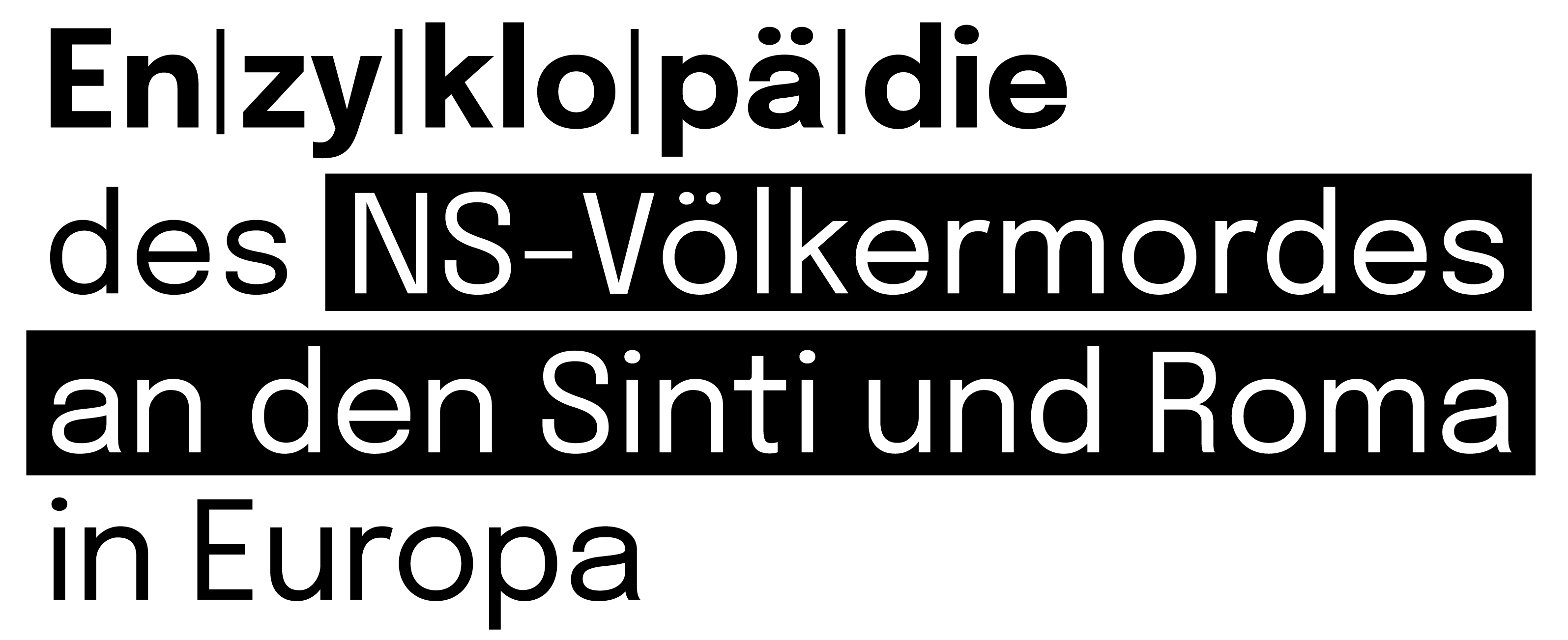The St. Josefspflege Catholic children‘s home in Mulfingen, Hohenlohe district in what is now Baden-Württemberg, Germany, served as the central collection centre for Sinti children in Württemberg from the end of 1938. The children had been transferred there in pursuance of Nazi racial policy. The home is well known because the children were used in Eva Justin’s (1909–1966) field research and subsequently deported to the Auschwitz-Birkenau concentration and extermination camp. It symbolises the racist exclusion of Sinti and Roma children and young people from the care system and their consignment to systematic murder.
Admission to the Home
According to a decree issued by the Württemberg Minister of the Interior on 7 November 1938, all school-age ‘Gypsies and Gypsy-like persons’ (the latter referred to Yenish People) from Württemberg already resident in care homes were to be housed centrally in the St. Josefspflege.1Cf. Hauptstaatsarchiv Stuttgart, E 151/09 Bü 442, Decree of the Württemberg Minister of the Interior, 7 November 1938 (‘Homes Decree’). The decision about which children should be sent to the home was made on the basis of an expert opinion by the state medical officer for young people Dr Max Eyrich (1897–1962) in Stuttgart, who categorically advocated that they should be ‘selected out’ on the basis of hereditary biology. The younger children were initially placed in other homes and then transferred to Mulfingen to start school. The children at St Josefspflege were cared for by the Sisters of Mercy of the Untermarchtal convent and the teacher Johanna Nägele (1915–2011). Many had been placed under the care of the state after their parents had been sent to concentration camps.
Field Research
In early autumn 1942, Eva Justin, Robert Ritter’s (1901–1951) closest collaborator at the Racial Hygiene Research Unit (RHF), carried out extensive research for her dissertation on 21 selected Sinti children at St. Josefspflege, including pseudo-psychological tests such as ‘performance potato sorting’. Portrait photos of the children were taken and a 16 mm colour film made as part of this research.2Some of the portrait photos are available at https://www.sintiundroma.org/de/auschwitz-birkenau/deportation-aus-heimen/. The approximately one and a half minute film sequence is available at https://www.youtube.com/watch?v=A5DDRy0I9rU [accessed: 23/02/2025]. In 1943 Justin, who had been enrolled at Friedrich Wilhelm University in Berlin (now Humboldt University) since 1937, submitted her doctoral thesis to the Faculty of Mathematics and Natural Sciences in the Department of Anthropology. The dissertation was graded ‘good’ and was published in 1944 under the title ‘Lebensschicksale artfremd erzogener Zigeunerkinder und ihrer Nachkommen’. At the heart of her argument is the dogma of her mentor and supervisor Dr Robert Ritter that the ‘Gypsies’ were congenitally ‘ineducable’ and that their ‘hereditary fate’, determined before birth, could not be changed. Even though her observations in the home clearly contradicted this premise, she demanded an end to all educational measures and, with a few exceptions, the forced sterilisation of Sinti and Roma in order to protect the German ‘Volkskörper’ [national body].
Deportation on 9 May 1944
On 19 December 1942—three days after the Auschwitz decree by Reichsführer-SS Heinrich Himmler (1900–1945)–the Reich Minister of the Interior called on the youth welfare offices at Gau and state level to ‘submit a list of the underage Gypsies in residential care’.3Rose, Den Rauch hatten wir täglich vor Augen, 288. According to the decree, the children were to be handed over to relatives to be deported with them to Auschwitz-Birkenau from March 1943.
The deportation of the Mulfingen children did not actually take place until 9 May 1944, but the reason for this late date cannot be determined with certainty from the surviving files. Earlier studies assumed that there was a connection between the time the children were collected and the formal completion and thus the legal validity of Justin’s dissertation. Reimar Gilsenbach (1925–2001) argued that Justin ‘could … be sure that she no longer needed her “research material”‘ only after the publisher had sent 120 copies of the printed version to Berlin University on 9 March 1944.4Gilsenbach, „Wie Lolitschai zur Doktorwürde kam“, 118; see also Krausnick, Wo sind sie hingekommen?, 105. On closer inspection, this interpretation, which has had wide circulation, is not very plausible: Given the protection she enjoyed from Ritter, who was very well connected within the power structure of the Nazi state, Justin had no reason to fear that her doctorate would fail. In 2006, Stephan M. Janker (born 1957) referred to an exchange of letters between the Central Administration for Foundations and Institutions and the Württemberg State Youth Welfare Office, which showed that ‘from the beginning of April 1943 at the latest, it was expected that places would become available in Mulfingen “if the Gypsy children still there were placed elsewhere”.’5Janker, Die Geschwister Kurz – vier Stuttgarter Sinti-Kinder, 152. He attributed the late deportation to the admission freeze imposed on 15 May 1943 on Camp Section BIIe in Auschwitz-Birkenau, which was not officially lifted until March 1944. This theory is supported by the fact that about a month after the deportation of the Mulfingen children, another four children, this time from the St. Josef Catholic children’s home in Eltmann (Lower Franconia), were sent to Auschwitz-Birkenau, where they arrived on 17 June 1944 on one of the last transports.6Staatsarchiv Nürnberg, LRA Uffenheim, Abg. 1956, Nr. 2036; Gedenkbuch vol. 1, 722 f. and Gedenkbuch vol. 2, 1326 f.
The course of the deportation from Mulfingen can be substantially reconstructed. At the beginning of 1944, officers from the Stuttgart criminal police appeared at St. Josefspflege to check the personal details of the Sinti children and take their fingerprints, probably on the ‘form for the detention of Gypsy Mischlinge‘ designed for this purpose. A short time later, the management of the home received written instructions with a list of the children who were to be prepared for transport to an unknown destination. On 7 May, a Sunday, the children—including those who were actually too young—received their First Communion in the home’s chapel. The management made no attempt to prevent the deportation of the children.
On 9 May, three gendarmes picked up 33 children and young people who were listed as ‘Gypsy Mischling children’ in a list from the ‘Office for Gypsy Affairs’ of the Stuttgart Regional Criminal Police Headquarters dated 14 June 1944. Angela Reinhardt (born 1934), who was ten years old at the time, was left behind. Although she had been classified by the RHF as a ‘Gypsy Mischling’ and was therefore included in the group of people to be deported, she was not on the deportation list—presumably because she was listed in the St. Josefspflege records under the name of her biological mother, who was not a Sintiza.
Sister Eutychia Herold (1885–1965), the matron in Mulfingen, and Johanna Nägele, asked to be allowed to accompany their protégés on the beginning of their journey. The bus travelled to the station in Künzelsau, where a railway car with barred windows was waiting on a siding to be attached to trains departing on schedule for Crailsheim. Nägele and Herold had to say goodbye to the children there. In Crailsheim, other people boarded the train: Albert Kurz (1938–1944) from the Baindt children’s home, Rosina (1933–1944) and Heinz Winter (1941–1944) from the Hürbel children’s home and the heavily pregnant Anna Reinhardt (1916–1944) with her two daughters Hildegard (1941–1944) and Sophie (1935–1944). Adolf Scheufele (1892–1981) from the ‘Office for Gypsy Affairs’ of the Stuttgart Regional Criminal Police Headquarters was also waiting there to supervise the deportation. A female criminal police officer from Esslingen named Kienzle (no further details known) accompanied the prisoners in the car to Auschwitz-Birkenau. After more than 50 hours on the train, the 39 deportees arrived on 12 May. Survivor Amalie Schaich, née Reinhardt (1929–2010), reported that the Mulfingen children in Camp Section BIIe remained together in Block 16 for another 14 days; after that, the smaller children were transferred to the so-called ‘orphan block’.7Gedenkbuch, vol. 2, 1532–1534.
Earlier Deportations
The transport of 9 May 1944 was not the first deportation of children from Mulfingen to Auschwitz-Birkenau. Criminal police officers had already picked up the four siblings Maria Delis (1937–1944), Rudi Delis (1935–1944), Luana Schneck (1934–1944) and Siegfried Schneck (1929–1944) from St. Josefspflege on 20 January 1944. The date of their arrival in Auschwitz-Birkenau is recorded as 11 February 1944. Patrizka Georges (1925–1943), who had lived in the Mulfingen home until May 1941 and was then housed as a maid with a farming family, was deported to Auschwitz-Birkenau in the spring of 1943; her date of death is recorded as 25 October 1943. Other older residents of the home who worked for local farmers after finishing school were able to escape the persecution.
Only Three Survivors
As Laura Hankeln (born 1991) was able to show in her dissertation published in 2024, a total of 38 children and young people (not 39 as previously assumed) who had been housed in St. Josefspflege were deported to Auschwitz-Birkenau. Only three of them survived: Rosa Georges, married name Alter (1927–unknown), Luise Mai, married name Würges (1929–unknown) and Amalie Reinhardt, married name Schaich.8Hankeln, Antiziganismus im baden-württembergischen Staatsapparat 1945–1970 , 323–328. Most of the children from Mulfingen were murdered in the gas chambers on the night of 2 to 3 August 1944.
Andreas Reinhardt (1929–1944), who is cited in older literature as another survivor, was transferred to the Buchenwald concentration camp shortly before this murder, but was sent back to Auschwitz-Birkenau on 26 September 1944 with 199 other Sinti and Roma children and young people and murdered there.
The Search for Justice
After liberation, parents who had themselves been interned in concentration camps set out on the often lengthy search for their children who had been held in Mulfingen and learned of their deaths in Auschwitz-Birkenau.9See, for example, the letter from Franziska Kurz to the matron of St. Josefspflege dated 30 January 1946 https://www.romarchive.eu/de/collection/die-antwort-war-kurz-vernichten/ [accessed: 23/02/2025].
Members of the police establishment responsible for the deportation were never held legally accountable. It was not until June 1972 that the crime came to the attention of the authorities, when the social worker Johannes Meister (1918–1989), who had been researching the persecution of the Mulfingen children, wrote several letters to the Baden-Württemberg State Office of Criminal Investigation (Landeskriminalamt, LKA), explicitly asking about the perpetrators. The Stuttgart public prosecutor’s office then opened an investigation against unknown persons and commissioned the LKA to question witnesses. Between January and May 1973, two LKA officers questioned Meister, the former teacher Nägele and the three surviving women. While Rosa Alter (née Georges) stated that she no longer wanted to be reminded of the past, Luise Würges (née Mai) and Amalie Schaich (née Reinhardt) provided detailed information about the course of the deportation and their experiences in the camp, which were characterised by violence and mass killing. As they were unable to provide any further information about the perpetrators and numerous witnesses had died in the meantime, the Stuttgart public prosecutor’s office discontinued the proceedings on 24 January 1974.10Hankeln, Antiziganismus im baden-württembergischen Staatsapparat 1945–1970, 311–323.
Living Memory
It was not until the TV documentary ‘Auf Wiedersehen im Himmel’ [‘See You in Heaven’] directed by Michail Krausnick (1943–2019) and Romani Rose (born 1946), was broadcast on ARD on 4 August 1994, that the story of the suffering of the Mulfingen children received widespread public attention. The film gives ample space to the testimonies of the survivors. It places the events in the St. Josefspflege in the wider context of the genocide of the Sinti and Roma and raises the question of the responsibility of the Catholic Church.11An excerpt of the film is available at https://www.romarchive.eu/en/collection/well-meet-again-in-heaven/ [accessed: 23/02/2025].
The ‘Mulfingen Sinti children’, whose story has been included in numerous exhibitions and educational projects,12For example https://romasinti.eu/de/#story/amalie-schaich-reinhardt [accessed: 23/03/2025]. now have a firm place in the culture of remembrance. On 2 June 1984, a memorial plaque with the names of the children was unveiled on the main building of St. Josefspflege, an initiative of both the staff there and the Central Council of German Sinti and Roma. As part of the ‘Education after Auschwitz’ project, the home is intensively analysing its history.13See https://www.josefspflege.de/bischof-von-lipp-schule/erziehung-nach-auschwitz/ [accessed: 23/02/2025]. To this day, Mulfingen remains an important point of reference for the relatives of the victims as well as for civil society. The murdered children are regularly remembered, particularly on the anniversaries of the deportations.14For example https://www.josefspflege.de/news/artikel/news/gedenkfeier-zum-80-jahrestag-der-ermordeten-sinti-kinder-der-st-josefspflege/?tx_news_pi1%5Baction%5D=detail&tx_news_pi1%5Bcontroller%5D=News&cHash=9d7c47f23db0196730e4f65c1bbd9711&L=0 [accessed: 23/02/2025].
A memorial to the Mulfingen children created by the artist Wolfram Isele (born 1952) has been on display in the foyer of the Stuttgart Youth Welfare Office since 2000; it also symbolises the involvement of the public social services and professional social work in Nazi crimes.15Cf. stuttgart.de/organigramm/adresse/wolfram-isele-aktenordnung-denkmal-fuer-die-mulfinger-kinder.php [accessed: 23/02/2025].
Stumbling stones for the Kurz siblings from Bad Cannstatt were laid in front of their former home in Badergasse.16Cf. https://www.stolpersteine-stuttgart.de/presse/stolpersteine-in-bad-cannstatt-von-cannstatt-ueber-mulfingen-in-den-tod/ [accessed: 23/02/2025]. In Nürtingen, a wooden sculpture created by the British sculptor Robert Koenig (1951–2023) has commemorated Anton Köhler (1932–1944), who was born in the town and murdered in Auschwitz-Birkenau at the age of twelve, since July 2015.17Cf. archive.org/web/20160203195229/http://ns-opfer-nt.jimdo.com/w%C3%A4chter-der-erinnerung/ [accessed: 23/02/2025].
The confrontation with the perpetrators also continues. The report of the Independent Commission on Antigypsyism submitted to the Federal Government in 2021 recommends that the Berlin Humboldt University review Eva Justin’s doctorate ‘from a formal legal, scientific and scientific-ethical point of view’ and, if necessary, withdraw its approval as a qualification for the doctoral degree.18Unabhängige Kommission Antiziganismus, Perspektivwechsel. Nachholende Gerechtigkeit. Partizipation, 370.




